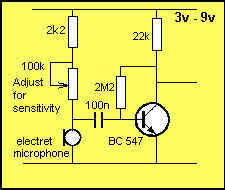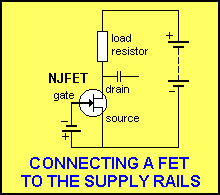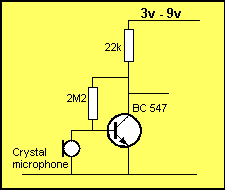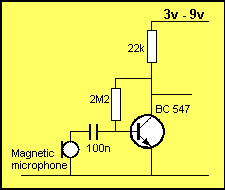Table Of Contents
The AMP METER
THE MICROPHONE
Basically there are two different types. One PRODUCES a voltage and the other REQUIRES a voltage for its operation.
This means you need to supply energy to the second type and this is very important when you are designing a battery-operated circuit and need to have a very low quiescent current.
Here is a list of different types of microphones and their advantages:
SUPPLY VOLTAGE REQUIRED:
Electret Microphone - sometimes called a condenser microphone. Requires about 2-3v @ about 1mA.
Extremely good reproduction and sensitivity - an ideal choice. Output - about 10 - 20mVCarbon Microphone - also called a telephone insert or telephone microphone. Requires about 3v - 6v. Produces about 1v waveform. Not very good reproduction. Ok for voice.
NO SUPPLY VOLTAGE REQUIRED:
Crystal Microphone - also called a Piezo microphone.
Produces about 20-30mV
Produces a very “tinny” sound - like talking into a tin.Dynamic Microphone - also called a Moving-Coil, Moving-Iron, Magnetic Microphone or Ribbon Microphone. Very good reproduction. Produces about 1mV.
A speaker can be used as a microphone - it is called a Dynamic Mic. or Magnetic mic. - output about 1mV
If a microphone produces about 20mV under normal conditions, you will need a single stage of amplification. If the microphone produces only 1mV under normal conditions, you will need two stages of amplification.
The circuits below show the first stage of amplification and the way to connect the microphone to the amplifier.

Connecting an electret microphone.
The 100n capacitor separates the voltage needed by the microphone (about 1-2v) from the 0.6v base voltage. A good electret microphone can hear a pin drop at 2 metres. A poor quality electret mic produces crackles in the background like bacon and eggs frying.

The internal construction of an electret microphone.
Air enters the electret mic via the top holes and moves the thin mylar sheet. This changes the distribution of the charges on the plastic and the changes is passes down the Gate lead to the FET. The FET amplifies the signal and the result is available on the Drain lead.
The “charged cell” is connected between ground and Gate.


Connecting a Crystal microphone.
The crystal microphone has an almost infinite impedance - that’s why it can be connected directly to the base of the transistor.

Connecting a Magnetic microphone.
The magnetic microphone has a very low internal resistance and needs a capacitor to separate it from the base of the amplifying stage. If it is connected directly, it will reduce the base voltage to below 0.7v and the transistor will not operate.
Quick Links
Legal Stuff
Social Media


